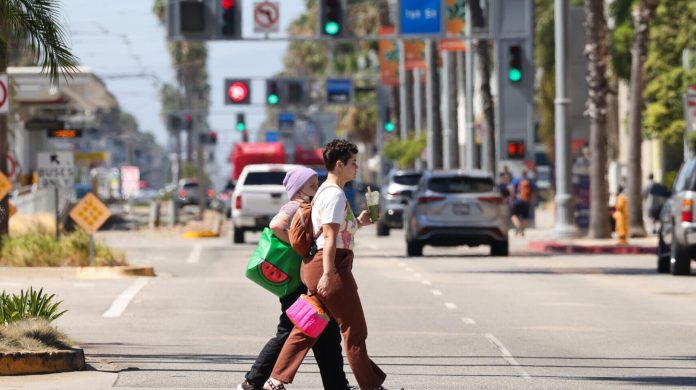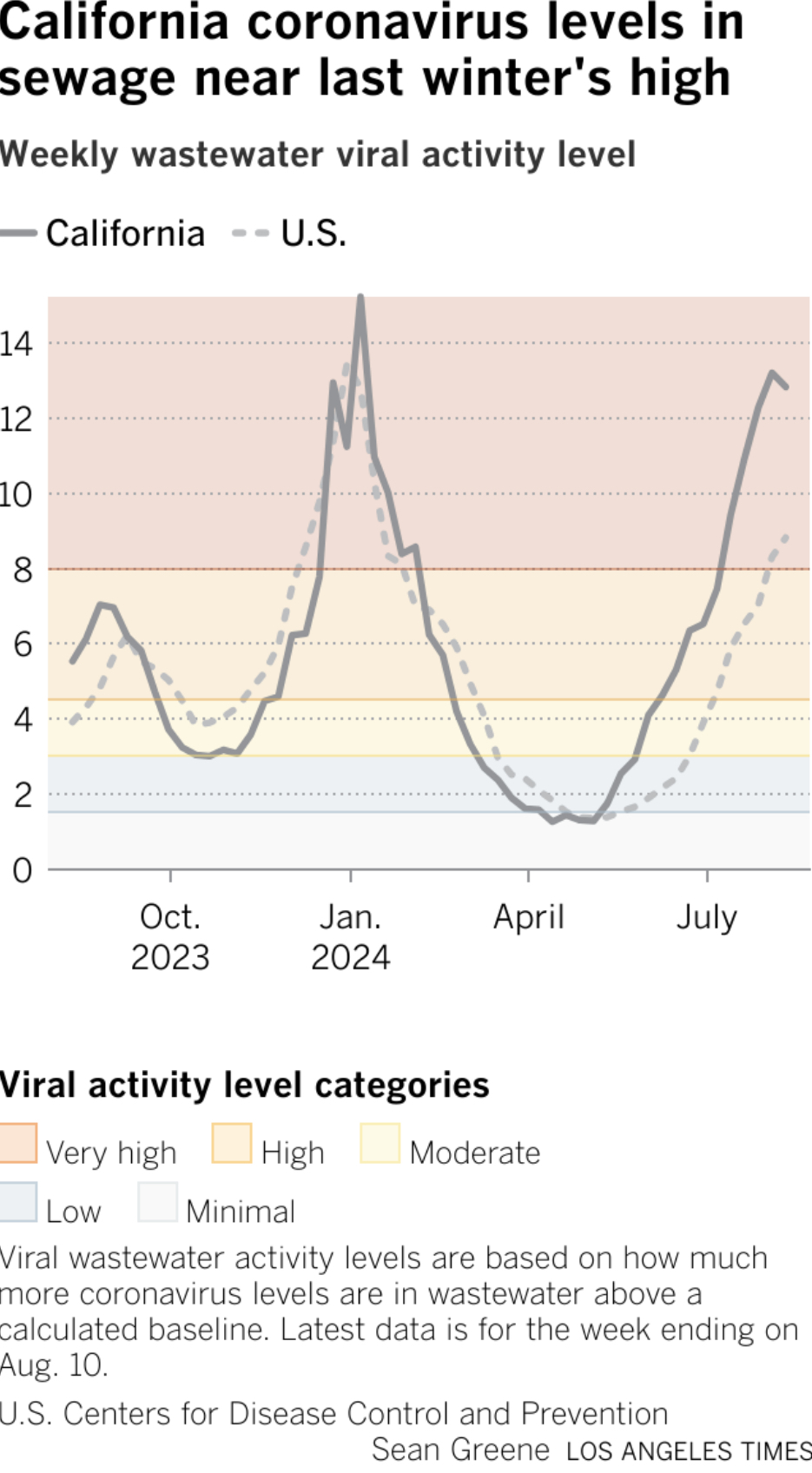California’s FLiRT-fueled COVID surge is continuing to spawn infections at a dizzying rate, with coronavirus levels in wastewater reaching some of the highest levels seen since 2022.
California’s relentless FLiRT-fueled COVID surge is continuing to spawn infections at a dizzying rate, with coronavirus levels in wastewater reaching some of the highest levels seen since 2022.
Wastewater readings are now higher than all but one COVID peak in the last two years, and have far surpassed those seen during the typical summertime seasonal spikes in the vaccine era.
“This is a very large surge that we are seeing currently. This is starting to rival, really, what we saw this past winter,” said Dr. Elizabeth Hudson, regional chief of infectious diseases at Kaiser Permanente Southern California.
For the week that ended Aug. 10, coronavirus levels in sewage were 84% of last winter’s peak in California, according to estimates posted Friday by the U.S. Centers for Disease Control and Prevention. Coronavirus levels in wastewater have already blown past the peaks for the prior two summers, as well as the winter of 2022 to 23.
“It’s so surprising to me that it hasn’t gone down yet,” said Dr. Peter Chin-Hong, an infectious diseases specialist at UC San Francisco. “It’s a little bit more of a prolonged season for California.”
There are few signs that the surge is losing steam.
The rate at which COVID-19 tests are coming back positive continues to rise. In California, 14.7% of tests done at medical facilities came back positive over the week ending Aug. 12, a rate greater than was ever seen last winter and summer. A month ago, the test positivity rate was 10.6%.
For the 10-day period that ended Aug. 3, coronavirus levels in Los Angeles County wastewater jumped to 76% of last winter’s peak, up from 54% for the 10-day period that ended July 27.
And in Santa Clara County, the most populous in the San Francisco Bay Area, coronavirus levels in wastewater were considered high in three highly populated sewersheds serving San José, Palo Alto and Sunnyvale.
The FLiRT subvariants have been the major culprits behind this summer’s COVID spike, with one in particular starting to flex its hyper-infectious muscle. KP.3.1.1 is now the single most common coronavirus strain circulating nationwide, constituting an estimated 36.8% of specimens for the two-week period that ended Saturday, up from 12.7% a month ago, CDC data show.
“It’s this confluence of a much more infectious variant on top of folks’ overall immunity having waned — either from natural or vaccine-induced immunity,” Hudson said. “It’s just kind of come [as] a perfect storm.”
This summer’s wave is shaping up to be particularly long-lasting. California has seen “high” or “very high” levels of coronavirus in its wastewater for the last 10 weeks. In the summer of 2022, California spent 16 weeks in either of those categories, and in the summer of 2023, the state recorded eight weeks with “high” viral wastewater levels.
Cases — though assuredly an undercount, as they don’t account for people who test at home, or not at all — are nevertheless climbing. There were an average of 484 COVID-19 cases a day for the week that ended Aug. 11 in L.A. County, up 35% over the last month. Last summer’s peak was 571 cases a day.
And COVID is sending more people to emergency rooms. For the week that ended Aug. 11, 4.3% of emergency room visits countywide were related to the coronavirus, up from 4% the prior week. Last summer’s peak was 5.1%.
Hospitalizations are ticking up, but remain a fraction of numbers from prior summers. Even in a period of rampant infection, severe illness from COVID-19 has been less common, thanks to prior immunity and widespread availability of anti-COVID medicines such as Paxlovid.
For the week that ended Aug. 10, there was a daily average of 462 coronavirus-infected people in the hospital in L.A. County, up from 407 the prior week. Last summer’s peak was 620, last winter’s was 825, and in the summer of 2022 it was more than 1,100.
At Kaiser Permanente Southern California, which covers more than 4.8 million members, the uptick in COVID has mainly resulted in increased visits to clinics and doctor’s offices.
“We’re not seeing a huge number of people who are admitted to the hospital with COVID,” Hudson said.
COVID-19 deaths in L.A. County remain relatively stable, averaging one to two per day, although it can take time for a surge in cases to show up in fatality data.
Still, though well shy of the pandemic’s devastating early years, the overall burden of COVID remains significant. Since October, more than 49,000 COVID-19 deaths have been reported nationally, compared with at least 25,000 flu deaths that have been estimated over the same time period. An updated estimate of flu deaths is expected later this year.
“COVID-19 remains a greater cause of severe illness and death than other respiratory viruses, but the differences between these rates are much smaller than they were earlier in the pandemic,” the CDC said in March.
Those at highest risk are those who are older or immunocompromised, and have not received an updated COVID-19 vaccine within the last year.
At some point, this summer peak will crest, and the pace of new infections will begin to decrease. But it won’t be clear until a few weeks after COVID indicators begin to fall.
An open question is whether COVID will continue to rise as kids go back to school. Doctors are urging people to stay home if they’re sick and asking parents to keep their ill kids from attending school, to limit spread of disease.
Initial estimates suggest the most recent week’s worth of viral levels in California wastewater are about 3% lower than the prior week. But that figure is subject to change as more data come in.
California is one of 25 states where COVID-19 is thought to be “growing” or “likely growing,” according to the CDC. COVID-19 was seen as “likely declining” in five states — Alaska, Florida, Hawaii, Louisiana and New York. COVID-19 was either stable or uncertain in 16 states and the District of Columbia. No estimates were available for Indiana, Missouri, Wisconsin and Wyoming.
Doctors urged people, as well as healthcare providers, to get tested or order testing for their patients when dealing with respiratory illness symptoms. An initial negative test doesn’t mean you don’t have COVID; doctors suggest testing for as long as five days after the onset of symptoms to see if a test turns positive.










